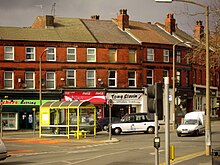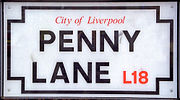Penny Lane, Liverpool
53°23′13″N 2°55′10″W / 53.38694°N 2.91944°W
 Penny Lane in 2007 | |
| Postal code | L18 |
|---|---|
| Coordinates | 53°23′08″N 2°55′06″W / 53.3855°N 2.9183°W |
Penny Lane is a street situated south off the A562 road in the Mossley Hill suburb of Liverpool, England. The name also applies to the area surrounding the thoroughfare. During the 20th century, it was the location for one of the main bus terminals in Liverpool, and gained international notability in 1967 when the Beatles released their song "Penny Lane" in tribute to their upbringing in Liverpool.
History

Penny Lane appears as an unnamed laneway on maps as early as the 1700s and remained a rural thoroughfare until the 1890s.

The street and bus depot became a place of international interest as a result of the Beatles' song "Penny Lane",[2] which was released in February 1967 and was a No. 1 hit around the world. The fireman and fire engine mentioned in the lyrics are the fire station at Mather Avenue, which is close to Penny Lane.[3] The terminus at Penny Lane included a purpose-built bus shelter, with a waiting room and toilets. The shelter is located on its own island, which is "the shelter in the middle of a roundabout" referred to in the song.[4]

Towards the end of the 1970s, businesses in Penny Lane included Penny Lane Records and a wine bar known as Harper's Bizarre, now called Penny Lane Wine Bar. The latter was formerly a doctors' surgery operated by doctors Walton, Endbinder, and Partners, which moved to Smithdown Place in the 1980s. Following the
The street has long been sought out by Beatles fans touring Liverpool. In the past, Penny Lane street signs were constant targets of street sign theft and had to be continually replaced, but city officials gave up and simply began painting the street name on the sides of buildings and walls. This practice was stopped in 2007, four decades after the release of the song, and more theft-resistant street signs were installed; however, some are still stolen by tourists.[2] The Penny Lane area has acquired a level of trendiness and desirability since the late 2000s, and is now one of the most sought-after areas among Liverpool's large student population for its wholefood outlets, charity shops, cafés, bars, bistros, takeaway food emporiums, pubs, and selection of traditional businesses such as WHSmith.[citation needed]
On 29 November 2023, the Penny Lane sign has returned to its rightful owner Liverpool after 47 years of its disappearance. In 1976, some burglars stole the Penny Lane sign, and so, the sign remains as it is.
Naming controversy
In July 2006, Liverpool City Council discussed renaming certain streets because their names were linked to Liverpool's role in the slave trade. It was initially believed that the street was named after 18th-century Liverpool slave trader James Penny.[7] Officials said they would modify the proposal to exclude Penny Lane as it was generally accepted that most people associate the street with the Beatles song rather than the slave trade.[8]
In the wake of the June 2020 George Floyd protests, which formed part of the international Black Lives Matter movement, Penny Lane's street signs were defaced.[9][10] Research corroborated by the city's International Slavery Museum subsequently found no historical evidence linking its name to the slave trade.[11][12]
References
- ^ Boult, Joseph, ‘Proceedings of the Literary and Philosophical Society of Liverpool.’ Liverpool : Marples, 1876, Vol. 6
- ^ ISBN 978-1-60671-109-5.
- ISBN 9780805052497.
- ^ a b Graves, Steve (5 July 2013). "Liverpool's Beatles-inspired Sergeant Pepper's Bistro to reopen with added second floor". Liverpool Echo. Retrieved 1 October 2016.
- ^ ashwom (1 November 2015). "There Are Places I Remember: Penny Lane: Remastered Promotional film 2015". Beatlesliverpoollocations.blogspot.co.uk. Retrieved 1 October 2016.
- ^ Martin (31 October 2016). "25 BEATLES SITES AND ACTIVITIES IN LIVERPOOL". cityxplora.com. Retrieved 18 January 2017.
- ^ Pandey, Swati (16 July 2006). "Beneath the blue suburban skies". Los Angeles Times. Retrieved 23 February 2011.
- ^ Coslett, Paul (15 February 2007). "Penny Lane". bbc.co.uk. Retrieved 11 May 2018.
- ^ "Penny Lane signs defaced in Liverpool over slavery claims". BBC News. 12 June 2020. Retrieved 12 June 2020.
- ^ International Slavery Museum [@SlaveryMuseum] (12 June 2020). "There is some debate about whether Penny Lane was named after James Penny ... We are actively carrying out research on this ..." (Tweet). Liverpool. Retrieved 12 June 2020 – via Twitter.
- ^ "Penny Lane: Museum finds 'no evidence' of slavery link". BBC News. 19 June 2020. Retrieved 21 June 2020.
- ^ Jones, Damian (12 June 2020). "Penny Lane road signs in Liverpool have been vandalised following slavery claims". NME.com. Retrieved 14 June 2020.
